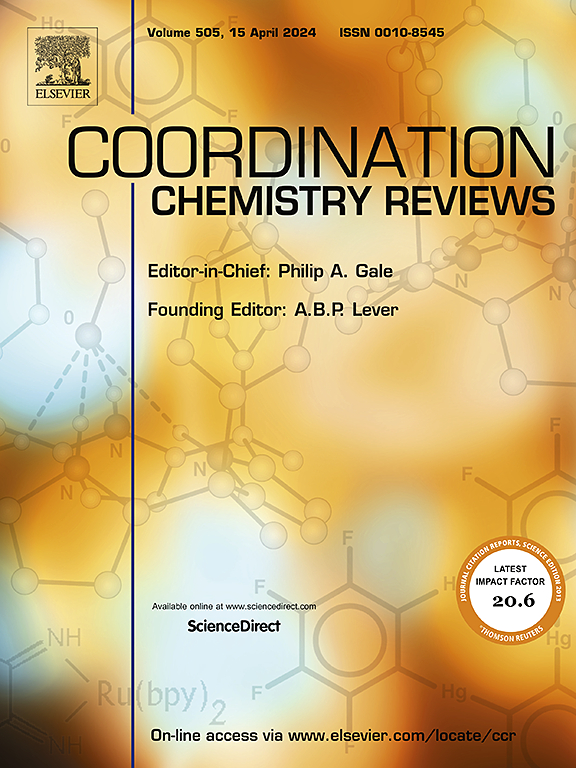Advances in metal-organic frameworks for cardiovascular therapy: from structural design to preclinical applications
IF 20.3
1区 化学
Q1 CHEMISTRY, INORGANIC & NUCLEAR
引用次数: 0
Abstract
Cardiovascular diseases are projected to account for over 40 % of global mortality by 2030, with current pharmaceutical treatments limited by poor pharmacokinetics, suboptimal biocompatibility, and concerns regarding long-term safety. Nanoparticles, including organic soft and inorganic hard nanoparticles, have shown promise as drug delivery systems, but face challenges to sufficient loading capacity and surface functionalization. Metal-organic frameworks (MOFs), an emerging class of inorganic-organic hybrid porous coordination solids, have emerged as transformative materials in modern engineering medicine, overcoming these limitations due to their high specific surface areas, tunable porosity, and flexibility in design. These properties, which can be tailored by selecting appropriate organic linkers and metal-containing nodes, enable MOFs to excel in drug loading and targeted delivery while maintaining favorable biocompatibility, thereby offering significant potential in cardiovascular treatment. Despite being cataloged in over 90,000 structures, the translation of MOFs from basic research to preclinical evaluation and eventual clinical applications remains underexplored. This review aims to bridge this gap by focusing on the design of MOFs tailored for cardiovascular therapeutic applications. It discusses the structure and properties of MOFs, including their metal and ligand selection, cargo loading and encapsulation capabilities, functionalization strategies and carbonization techniques, while highlighting their potential in the treatment of cardiovascular diseases such as atherosclerosis, thrombosis, myocardial infarction, and critical limb ischemia. We also discuss the challenges and limitations associated with MOFs, including structural validation, reproducibility, scalability and toxicity concerns, along with their translational potential. By connecting the fundamental design principles of MOFs to their preclinical cardiovascular applications, this review aims to inspire further research into the translation of MOFs into effective treatment for cardiovascular disease.
心血管治疗金属-有机框架的进展:从结构设计到临床前应用
到2030年,心血管疾病预计将占全球死亡率的40%以上,目前的药物治疗受到药代动力学差、生物相容性欠佳以及长期安全性问题的限制。纳米颗粒,包括有机软纳米颗粒和无机硬纳米颗粒,已经显示出作为药物递送系统的前景,但面临着足够的负载能力和表面功能化的挑战。金属有机框架(mof)是一类新兴的无机-有机杂化多孔配位固体,已成为现代工程医学中的变革性材料,由于其高比表面积,可调孔隙率和设计灵活性,克服了这些限制。这些特性可以通过选择合适的有机连接物和含金属节点来定制,使mof在保持良好的生物相容性的同时,在药物装载和靶向递送方面表现出色,从而在心血管治疗中提供了巨大的潜力。尽管在超过90,000个结构中进行了编目,但mof从基础研究到临床前评估和最终临床应用的转化仍未得到充分探索。这篇综述旨在通过关注为心血管治疗应用量身定制的MOFs设计来弥合这一差距。讨论了mof的结构和性质,包括金属和配体的选择、装载和封装能力、功能化策略和碳化技术,同时强调了它们在治疗心血管疾病如动脉粥样硬化、血栓形成、心肌梗死和严重肢体缺血方面的潜力。我们还讨论了与mof相关的挑战和限制,包括结构验证,可重复性,可扩展性和毒性问题,以及它们的转化潜力。通过将MOFs的基本设计原理与其临床前心血管应用联系起来,本综述旨在激发进一步研究将MOFs转化为有效治疗心血管疾病的方法。
本文章由计算机程序翻译,如有差异,请以英文原文为准。
求助全文
约1分钟内获得全文
求助全文
来源期刊

Coordination Chemistry Reviews
化学-无机化学与核化学
CiteScore
34.30
自引率
5.30%
发文量
457
审稿时长
54 days
期刊介绍:
Coordination Chemistry Reviews offers rapid publication of review articles on current and significant topics in coordination chemistry, encompassing organometallic, supramolecular, theoretical, and bioinorganic chemistry. It also covers catalysis, materials chemistry, and metal-organic frameworks from a coordination chemistry perspective. Reviews summarize recent developments or discuss specific techniques, welcoming contributions from both established and emerging researchers.
The journal releases special issues on timely subjects, including those featuring contributions from specific regions or conferences. Occasional full-length book articles are also featured. Additionally, special volumes cover annual reviews of main group chemistry, transition metal group chemistry, and organometallic chemistry. These comprehensive reviews are vital resources for those engaged in coordination chemistry, further establishing Coordination Chemistry Reviews as a hub for insightful surveys in inorganic and physical inorganic chemistry.
 求助内容:
求助内容: 应助结果提醒方式:
应助结果提醒方式:


